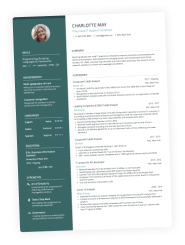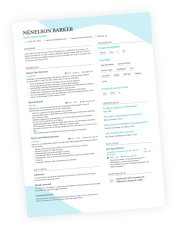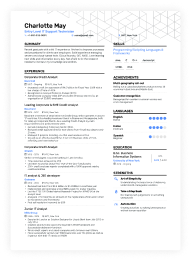Are you worried the text-heavy CV you’ve used for ages is getting lost in the hiring manager's inbox? Break out of the familiar and consider adding icons to your CV for more visual impact!
It may surprise you, but there’s a lot to consider with CV icons. They can be a great addition if they’re properly used… but they can be a comic tragedy used wrong.
Let’s make sure you hit the right notes on your CV.
In this article, we:
- Explain what CV icons are.
- Share the pros and cons of using icons on your CV.
- Tell you where and how to use icons for the best effect.
- We’re adding a bit about including logos, too.
- And we cover your best sources for finding or creating icons for your CV.
What are Icons on a CV?
The icons we’re talking about here are small, pictorial representations used to convey information visually and efficiently in a CV, not emojis in your main text – always avoid those! Icons are intended to accompany or replace text, streamlining your CV design, enhancing readability, and maximising whitespace.
For example, you might use a phone icon to identify your contact number, a graduation cap icon can signify your education or a computer icon might indicate your technical skills. Icons like these can make your CV more visually engaging and quickly convey information.
When using icons, ensure they’re relevant, appropriate, and aligned with industry norms for the specific job application. They are not for every situation and should always be used in moderation.
Should you use icons on a CV?
If you’re thinking about using icons on your CV, weigh the trade-offs. On one hand, they can enhance visual appeal and information transfer, but on the other, they may not suit conservative industries.
Relevance and professionalism are critical factors in your decision-making process. Icons may also cause compatibility issues with applicant tracking systems (ATS), affecting your CV's scannability and potential reach.
Here’s a rundown of the main pros and cons of using icons on your CV:
Pros
Visual appeal
Icons can enhance the visual appeal of your CV, making it more engaging and memorable. When used judiciously, they help your CV stand out in a competitive job market. They’re especially appropriate if you're in a creative field or targeting visual and design-oriented roles.
Efficiently informative
Icons efficiently convey information, making your CV more scannable. For instance, a phone icon next to your contact number or a graduation cap icon for your education section can help recruiters quickly locate and digest crucial details.
Modern and stylish
Incorporating icons can give your CV a stylish, modern look. This is often a benefit, particularly for positions where design skills are valued.
International recognition
Icons cross language barriers, making your CV more universally understandable if you're applying for positions in international settings.
Pros summary
The upshot of the pros is that icons on your CV can enhance its visual appeal, efficiently convey information, provide a modern look, and have international appeal. They can be great additions in creative fields or roles where design skills are relevant.
Cons:
Compatibility issues
Some ATS may struggle to process icons, potentially leading to issues with your CV being scanned or even rejected by automated systems.
Overuse risk
There's a danger of overusing icons, which can make your CV appear unprofessional or confusing if not used thoughtfully.
Relevance matters
The icons you use should be directly relevant to the content they represent. If they don't align with the information, they can look out of place and be confusing.
Industry norms
Traditional text-based CVs are the norm in conservative industries like law or finance. Using icons in these settings may be seen as unconventional and unprofessional.
Cons summary
As for the cons of icons, ATS compatibility issues, the risk of overuse, the importance of relevance, and consideration of industry norms are the primary drawbacks to using icons. Always prioritise clarity, professionalism, and compatibility when deciding to include icons on your
As you can see, there’s no one right answer about whether to use icons on a CV. Always consider the up- and downsides and tailor your CV for each application.
How to use icons on your CV
First and foremost, make sure the icons you choose will be recognisable to the person reading your CV. A recruiter isn’t going to take the time to figure out that a lion icon means you’re the king of the jungle on your sales team.
The size of your icons dramatically impacts how your CV looks and works. The right size will help draw attention to important details and make your CV look balanced.
Don't make icons too big. It wastes space and can draw too much attention.
But avoid making them too small, too. At a certain point, recruiters might struggle to recognise them, defeating their purpose.
Choose a style for your icons - extra points if it matches your personal brand - and use it consistently. It's best to use icons from the same pack for visual continuity and to maintain a professional look.
Colour is a powerful tool for seamlessly blending icons into the overall CV design. Choosing colours that harmonise with your CV's palette or personal brand can complement the document's overall design.
Careful placement within the text will impact how your icons come across. Align icons with the text's baseline and ensure the spacing between icons and text is consistent for a polished appearance.
Finally, too many icons can clutter your CV. Use icons in moderation, only to highlight key sections, and watch out to avoid making the page look unprofessional.
Where to use icons in your CV
You can strategically use icons in various CV sections to enhance clarity and visual appeal. A polished and professional look requires the icons to be relevant to the content and that you maintain a consistent style throughout.
Here are some key places and ideas to consider using CV icons. As we go down this list, the icons get more subjective and using all of them could start to get cluttered or confusing, so carefully consider when and how you might use them:
Contact information
The most common section to place icons is in the heading, next to contact details like phone numbers, email addresses, and location. Telephone, mail, and location pin icons are intuitive and more eye-catching than writing “Tel #:, Email:, and Address:”.
Something like this:
Emily Johnson
Address: 45 Oak Lane, Manchester, M2 2AB
Phone: 07890 123 456
Email: emily.j@email.com
Social Media
Icons can also accompany your social media links in the heading section. There are tons of simple icon versions of LinkedIn, X (formerly Twitter), Facebook, and all the professional social media platforms that you can use to let recruiters know where to find you.
For example:
LinkedIn: linkedin.com/in/sophieturner
Twitter: twitter.com/SophieTweets
Instagram: instagram.com/sophieturnerofficial
GitHub: github.com/sophieturner
Things start to get dicier as we go down here. So again, consider the icon and the specific role you’re applying to before including them in an application.
Skills section
Using icons to represent key skills on your CV can visually enhance the presentation, providing a quick and engaging way for employers to grasp your proficiency levels at a glance. This will vary for everyone’s specific skill set, but here’s an example from a digital marketer’s CV:
Skills:
Digital Marketing: Proven expertise in developing and implementing digital marketing strategies, including SEO, social media management, and content creation.
Communication: Strong written and verbal communication skills demonstrated through blogging, social media engagement, and content creation.
Analytics: Skilled in using analytics tools to track and analyze website and social media performance, with a focus on data-driven decision-making.
Achievements
Using icons in a CV achievements section adds a visually appealing element. It emphasizes key accomplishments at a glance and provides a quick and intuitive way for employers to grasp your successes.
See how this nurse showcased their achievements using icons:
Achievements:
Certified Registered Nurse: Attained the CRN designation, showcasing advanced knowledge and skills in patient care, clinical assessments, and healthcare protocols.
Clinical Innovation: Introduced a streamlined patient care process that resulted in a 15% reduction in patient waiting times.
Critical Care Management: Successfully managed critical care situations, ensuring timely interventions that led to a 20% decrease in adverse patient events within the unit.
Professional Development: Facilitated training sessions for junior nursing staff on infection control protocols, leading to a 30% reduction in hospital-acquired infections.
Awards
Likewise, you can use icons to highlight work, academic, or any kind of extracurricular awards you’ve received that demonstrate your strengths as a potential employee, like this graphic designer did:
Awards:
Graphic Design Excellence - UK Creative Industry Awards (2022): Recognized for innovative and impactful visual communication that elevated client brands.
Best Website Design - WebAwards UK (2021): Awarded for creating a visually compelling and user-friendly website design.
Young Designer of the Year - UK Design Council (2020): Recognized for exceptional talent and a fresh perspective in graphic design.
Print Design Innovation - Print & Design Awards UK (2019): Honored for pushing boundaries with innovative print design solutions.
Social Media Graphic Campaign - Digital Marketing Excellence Awards (2018): Achieved for a visually impactful social media campaign that boosted online engagement.
Hobbies and interests
Incorporating icons in a section on your hobbies or interestscan enhance visual appeal and succinctly convey personal interests. This adds a touch of creativity and can make your CV more engaging to a recruiter.
For example:
Hobbies:
Photography: Capturing moments and telling stories through various styles.
Hiking: Exploring UK landscapes, particularly the Lake District and Snowdonia.
Creative Writing: Contributing articles to personal blogs and local publications.
Cooking: Experimenting with diverse cuisines for friends and family.
Gardening: Cultivating flowers and herbs for relaxation.
Reading: Avid reader of fiction and non-fiction for personal and professional development.
What about a logo?
Modern CVs sometimes include a logo or picture at the top to one side or another of the heading section. While headshots deserve a conversation on their own, a logo can reinforce your personal brand or help you build one.
But including a logo on your CV can be a catch-22: If you don't have an established brand, advertising one can come off as (overly) bold. In some industries, that might be what they’re looking for, say in some finance jobs, but it would be a major turn-off for many recruiters.
So, deciding whether to add a logo is another case where you have to consider each situation. Either way, make sure you've got what it takes to back it up or consider building your brand before going all-in.
ATS compatibility concerns
Employers are increasingly using applicant tracking systems (ATS) as the first step in filtering and screening CVs. These systems scan CVs for specific keywords related to the job, skills, and qualifications.
ButATS can sometimes struggle to recognise or interpret icons as intended, potentially sending your CV to the bin before a human ever looks at it. So different CV sections need to be considered individually.
Your primary concern with ATS is to ensure it recognises your contact info, work experience, and skills. Luckily, ATS is actually pretty good at recognising these.
Most modern ATS will automatically recognise contact details, like phone numbers, emails, and names. So you don’t have to worry about icons throwing it off.
As for work experience, again, ATS has been designed to recognise these sections. But it’s best to use standard bullets to lead the work experience descriptions in this section.
ATS should also recognise your skills section as they’ve become quite good at interpreting language. So, well-placed icons will help set this section off once a recruiter gets to review it.
The same can be said about the remaining sections on your CV, like achievements, awards, hobbies and any other sections you include. ATS don’t focus on these sections, so they won’t get hung up on icons you use in them, and recruiters will recognise the well-chosen icons you include.
As a rule of thumb, it’s best to recognise that misread icons can hurt your chances. So use them sparingly and always prioritise clarity over aesthetic appeal.
The best sites and tools for CV icons
When it comes to incorporating icons into your CV, many websites and tools help you find and use them. But why scour the internet on your own when we’ve already collected the best of the best for you?
Here’s a round-up of the best websites and tools to help you incorporate icons in your CV:
- Flaticon offers an extensive library of free and premium icons. You can search for icons related to your field or profession and download them in various formats.
- FontAwesome is a widely used icon library with a vast collection of vector icons. It provides easy-to-use code snippets for web and digital applications.
- Of course,Enhancv is best known for its user-friendly online CV builder and templates. But that builder lets you seamlessly add icons to your CV for a strong, coordinated visual appeal and structure.
- Iconfinder is a platform that offers a wide range of icons for various applications. You can find icons suitable for CVs, download them in different formats, and even customise their colour.
- Noun Project is known for its simplicity and accessibility. It offers a collection of easily recognisable icons that can enhance the visual appeal of your CV.
- Canva is a user-friendly graphic design tool that includes an icon library. It's excellent for creating visually appealing CVs and customising icons to match your style.
- Icons8 provides a comprehensive library of icons for different purposes. You can customise the size, colour, and format of icons before downloading them.
- Iconmonstr offers a simple and clean collection of black and white icons. They are easy to incorporate into your CV and maintain a professional look.
- Figma is a collaborative design tool that provides access to a wide range of vector icons. It suits more advanced users who want to create a customised CV design.
- If you're usingMicrosoft Word to create your CV, you can access various icons from within the software. Go to the "Insert" tab, click on "Icons," and choose from multiple options.
- If you're proficient with graphic design, the industry-standardAdobe Illustrator allows you to create and customise your icons to perfectly match your CV's style.
- Alternatively, tryInkscape, a versatile, free, open-source vector graphics editor you can use to craft custom icons that suit your CV's style and content.
Frequently asked questions about CV icons
Can I use icons on my CV for any profession?
Yes, you can use icons on your CV for almost any profession, but ensure they are relevant to the content and industry norms.
How can icons enhance my CV?
Icons can make your CV visually appealing, help highlight key sections, and provide a quick visual reference for recruiters.
Are there any rules for using icons on a CV?
Use icons sparingly, ensure they are clear and straightforward, and match their style to the overall design of your CV.
Can icons replace text on a CV?
Icons should complement the text, not replace it. Use icons to visually support and clarify your content, not as a substitute for essential information.
Should I customise icons for my CV, or can I use pre-made ones?
You can do both. Pre-made icons are convenient and available on websites like Enhancv, but customising icons to match your CV's unique style can make it more distinctive.
Takeaways
- Icons boost visual appeal and help your CV stand out.
- They efficiently convey information, letting a recruiter quickly recognise essential information.
- Ensure icons are relevant and industry-appropriate.
- Beware of ATS compatibility issues; use icons sparingly.
- Consistency in style is vital for a professional look.
- Place icons thoughtfully, use them in moderation, and avoid clutter.



